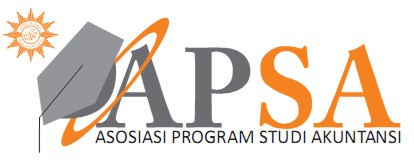Relevansi dan Interpretatif Laporan Keuangan Berdasarkan Metode General Price Level Accounting
Keywords:
Inflation, General Price Level Accounting, Historical Cost Accounting, NOD Attribute, COG attributeAbstract
The recent economic matters of Indonesia is sign of inflation. Inflation is a rise in the general level prices over time of a specific set of goods and services. In Indonesia, inflation rate is reported based on Consumer Price Index until 2007 always more than 5 percent unless in 1985 as 4.3 percent. The latest five year from 2003 to 2007 are 6.8%, 6.06%, 10.4%, 14,8% and 6.4%. It showed that a rise in the prices of a goods and services are influenced directly to change of purchasing power and production cost or the factors of production. Although the inflation is under two digits, inflation only above five percent is too high if its compare to gross national product. Generally, Financial Statements are arranged based on Historical Cost Accounting (HCA). By using this method, financial statements are arranged by using the price of transaction arise. As tool of measure or exchange in economy is used a monetary unit. Inflation is caused a monetary unit to be not stable. Financial statement is arranged based on Historical Cost Accounting not reflecting a change of purchasing power. Financial statement that reflect a change of purchasing power is General Price Level Accounting. This research uses case and field study by using purposive sampling. Analysis are using the number of dollar (NOD) attribute and the command over good (COG) attribute. NOD attribute is used to test that financial statements are interpretative and COG attribute is used to test that financial statements are relevance. The result of NOD attribute shows from 27 item, there are 92,59 percent is interpretative and the result of COG attribute, there are 74,07 percent is relevance. It means that financial statement is arranged by using General Price Level Accounting more interpretative and relevance than financial statement that arranged by using Historical Cost Accounting.
References
AICPA task force on conceptual framework. 1979. The Accounting Responses to Changing Prices: Experimentation with Four Models. New York: AICPA.
APB Statement No. 4. 1970. Basic Concepts and Accounting Principles Underlying Financial Statement of Business Enterprises. New York: AICPA.
Baridwan, Zaki. 1985. Akuntansi Keuangan Intermediate: Masalah-masalah khusus. Yogyakarta: BPFE.
Belkaoui, Ahmed. 1985. Accounting Theory, 2nd ed. Harcourt: Brace Jovanovich Publishing.
Chambers, R.J. 1966. Accounting, Evaluation and Economic Behavior, Englewood: Prentice Hall Inc.
Davidson, Sidney, et all. 1976. Inflation Accounting, A Guide For the Accountant and the Financial Analyst. New York: McGraw Hill.
Djojohadikusumo, Sumitro. 1990. Kajian Perekonomian Indonesia. Center for Policy Studies, Januari.
Drake, David and Dopuch, Nicholas. 1965. On The Case for Dichotomizing, Journal of Accounting Research, Autumn.
Edward, Edgar O and Bell, Philip W. 1961. The Theory and Measurement of Business Income. Los Angeles: University of California Press.
FASB. 1978. Objective of Financial Reporting by Business Enterprises. Statement of Financial Accounting Concepts No. 1.
FASB. 1980. Qualitative Characteristic of Accounting Information, Statement of Financial Accounting Concepts No. 2.
FASB. 1986. Recognition and Measurement in Financial Statements of Business Enterprises, Statement of Financial Accounting Concepts No. 5.
FASB. 1985. Element of Financial Statement, Statement of Financial Accounting Concepts No. 6.
FASB. 1979. Financial Reporting and Changing Prices, Statement of Financial Accounting Concepts No. 33.
FASB. 1984. Financial Reporting and Changing Prices: Elimination of Certain Disclosures, Statement of Financial Accounting Concepts No. 82.
Hadibroto, S. 1987. Masalah Akuntansi buku dua. Jakarta: LP-FEUI
Harahap, Sofyan Syafri. 1995. Teori Akuntansi. Jakarta: PT. RajaGrafindo Persada.
Hendriksen, Eldon S. 1982. Accounting Theory, 4th ed. Illinois: Richard D. Irwin, Inc.
Hicks, J.R. 1946. Value and Capital. Oxford: Clarendon Press.
Http://web.worldbank.org
http://www.bps.co.id/sector/cpi/table3.shtml
Ikatan Akuntan Indonesia. 2004. Standar Akuntansi Keuangan. Jakarta: Salemba Empat.
Kam, Vernon. 1986. Accounting Theory. New York: John Willy & Son.
Kodrat, David Sukardi, 2006. Studi Banding Penyusunan Laporan Keuangan dengan Metode Historical Cost Accounting dan General Price Level Accounting pada Masa Inflasi, Jurnal Akuntansi dan Keuangan, Vol. 8. No. 2, Nopember 2006: 78 – 91.
Leng, Pwee. 2002. Analisis Terhadap Perlunya Penyesuaian Laporan Keuangan Historis (Conventional Accounting) Menjadi Berdasarkan Tingkat Harga Umum (General Price Level Accounting), Jurnal Akuntansi dan Keuangan Vol. 4/2, November.
Muljono, Teguh Pudjo. 1995. Analisa Laporan Keuangan untuk Perbankan, Edisi Revisi 3. Jakarta: Djambatan.
Na'im, Ainun. 1989. Akuntansi Inflasi. Yogyakarta: BPFE.
Oppusunggu. HMT. 1992. Trend Nilai Rupiah. Info Bank, Januari.
Paton, William and Littleton, A.C. 1940. An Introduction to Corporate Accounting Standards, AAA.
Prakash, Prem and Sunder, S. 1979. The Case Against Separation of Current Operating Profit and Holding Loan, Accounting Review, January.
Revsine, Lawrence. 1979. On The Correspondence Between Replacement Cost, Income and Economic Income. The Accounting Review, July.
Revsine, Lawrence. 1973. Replacement Cost Accounting. New York: Prentice Hall.
Rosenfield, Paul. 1981. A History of Inflation Accounting, Journal of Accountancy, September.
Schroeder, Richard G. and Clark, Myrtle. 1995. Accounting Theory: Text & Reading, New York: John Willy & Sons.
Sterling, Robert R. 1975. Relevant Financial Reporting in an Age of Price Changes, The Journal of Accounting, February.
Suwardjono, 2005. Teori Akuntansi Perekayasaan Pelaporan Keuangan, Yogyakarta: BPFE.
Sweeney, Hendry W. 1927. Effects of Inflation on German Accounting. Jofa. March.
Downloads
Published
How to Cite
Issue
Section
License
License
 Journal of Accounting and Investment is licensed under Creative Commons Attribution Attribution-NonCommercial-NoDerivatives 4.0 International License.
Journal of Accounting and Investment is licensed under Creative Commons Attribution Attribution-NonCommercial-NoDerivatives 4.0 International License.




